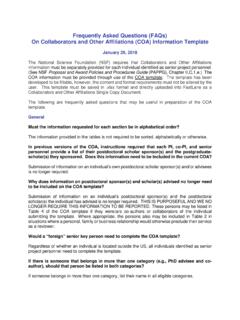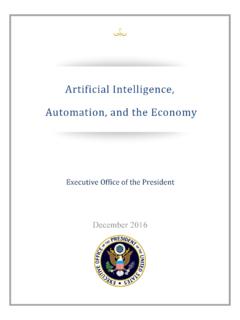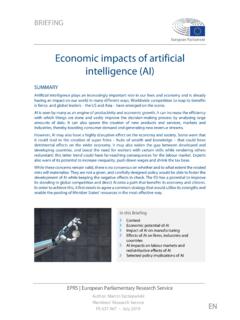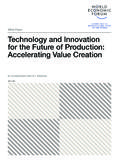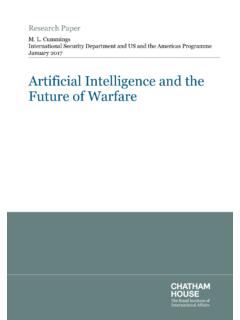Transcription of National Artificial Intelligence (AI) Research Institutes ...
1 National Artificial Intelligence (AI) Research Institutes Accelerating Research , Transforming Society, and Growing the American Workforce PROGRAM SOLICITATION. NSF 22-502. REPLACES DOCUMENT(S): NSF 20-604. National Science Foundation Department of Homeland Security, Science & Technology Directorate Institute of Education Sciences, Department of Education National Institute of Food and Agriculture National Institute of Standards and Technology Department of Defense Office of the Under Secretary of Defense for Research and Engineering IBM Corp. Preliminary Proposal Due Date(s) (required) (due by 5 submitter's local time): January 14, 2022.
2 Full Proposal Deadline(s) (due by 5 submitter's local time): May 13, 2022. IMPORTANT INFORMATION AND REVISION NOTES. Revision Summary: 1. This solicitation significantly extends the time and process afforded for the development of proposals. See the program calendar under Program Description. Preliminary proposals are now required as a method to increase both the quality of eventual full submissions and to reduce the proposers' unnecessary effort in preparation of proposals that are unlikely to be successful for a competition that will result in a small number of awards.
3 Desiderata for AI Research Institutes , proposal submission instructions, and solicitation-specific review criteria are revised to stress the role and importance of foundational AI Research . Desiderata and proposal submission instructions have been revised to emphasize the importance of achieving a whole that is greater than the sum of the parts through both internal synergies and external partner engagement. New themes for Institute proposals (see Program Description). Agency and Industry partners on this solicitation have changed. Guidelines for the participation of the industry sponsor and its affiliated personnel in proposals to this solicitation apply only to the sponsored theme and are detailed in the program description.
4 Restrictions apply only to the partner listed in this solicitation. Any proposal submitted in response to this solicitation should be submitted in accordance with the revised NSF Proposal & Award Policies & Procedures Guide (PAPPG) (NSF 22-1), which is effective for proposals submitted, or due, on or after October 4, 2021. SUMMARY OF PROGRAM REQUIREMENTS. General Information Program Title: National Artificial Intelligence (AI) Research Institutes Synopsis of Program: Artificial Intelligence (AI) has advanced tremendously and today promises personalized healthcare; enhanced National security; improved transportation; and more effective education, to name just a few benefits.
5 Increased computing power, the availability of large datasets and streaming data, and algorithmic advances in machine learning (ML) have made it possible for AI Research and development to create new sectors of the economy and revitalize industries. Continued advancement, enabled by sustained federal investment and channeled toward issues of National importance, holds the potential for further economic impact and quality-of-life improvements. The 2019 update to the National Artificial Intelligence Research and Development Strategic Plan, informed by visioning activities in the scientific community as well as interaction with the public, identifies as its first strategic objective the need to make long-term investments in AI.
6 Research in areas with the potential for long-term payoffs in AI. The National AI Research Institutes program enables longer-term Research and leadership in AI through the creation of AI Research Institutes . This program is a joint government effort between the National Science Foundation (NSF), Department of Agriculture (USDA) National Institute of Food and Agriculture (NIFA), Department of Education (ED) Institute of Education Sciences (IES), Department of Homeland Security (DHS) Science & Technology Directorate (S&T), National Institute of Standards and Technology (NIST), Department of Defense (DOD) Office of the Under Secretary of Defense for Research and Engineering (OUSD (R&E)), and IBM Corporation (IBM).
7 This program solicitation expands upon the nationwide network established by the first 18 AI Research Institutes to pursue transformational advances in a range of economic sectors, and science and engineering fields. In this round, the program invites proposals for Institutes that have a principal focus in one of the following themes, detailed in the Program Description: Theme 1: Intelligent Agents for Next-Generation Cybersecurity Theme 2: Neural and Cognitive Foundations of Artificial Intelligence Theme 3: AI for Climate-Smart Agriculture and Forestry Theme 4: AI for Decision making Theme 5: Trustworthy AI.
8 Theme 6: AI-Augmented Learning to Expand Education Opportunities and Improve Outcomes Cognizant Program Officer(s): Please note that the following information is current at the time of publishing. See program website for any updates to the points of contact. AI Research Institutes Program Team, telephone: (703) 292-5111, email: Applicable Catalog of Federal Domestic Assistance (CFDA) Number(s): --- USDA-NIFA Agriculture and Food Research Initiative --- Engineering --- Mathematical and Physical Sciences --- Geosciences --- Computer and Information Science and Engineering --- Biological Sciences --- Social Behavioral and Economic Sciences --- Education and Human Resources --- Office of International Science and Engineering --- Office of Integrative Activities (OIA).
9 --- Institute of Education Sciences, Department of Education --- Department of Homeland Security, Science & Technology Directorate 2. Award Information Anticipated Type of Award: Cooperative Agreement Estimated Number of Awards: 7. NSF plans to make approximately one Institute award in each of themes 1-5, and one award to each of the two tracks listed in theme 6 as described below. Anticipated Funding Amount: $140,000,000. Institute awards will be made for between $16,000,000 and $20,000,000 for four to five years ($4,000,000 per year on average). Proposals outside this range may be returned without review.
10 Estimated program budget, number of awards and average award size/duration are subject to the availability of funds. Eligibility Information Who May Submit Proposals: Proposals may only be submitted by the following: Institutions of Higher Education (IHEs) - Two- and four-year IHEs (including community colleges) accredited in, and having a campus located in the US, acting on behalf of their faculty members. Special Instructions for International Branch Campuses of US IHEs: If the proposal includes funding to be provided to an international branch campus of a US institution of higher education (including through use of subawards and consultant arrangements), the proposer must explain the benefit(s) to the project of performance at the international branch campus, and justify why the project activities cannot be performed at the US campus.
